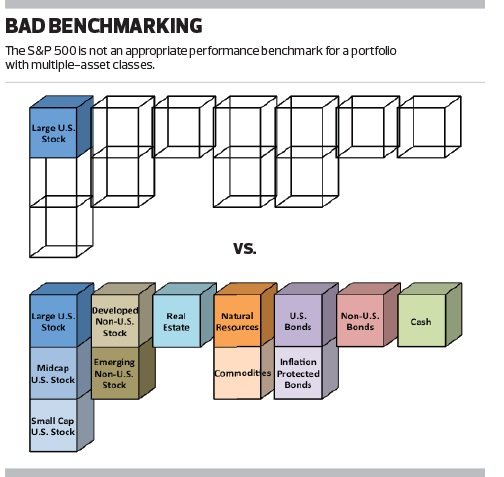Craig L. Israelsen has a nice article in Financial Planning Magazine entitled, “Best Benchmarks for Client Portfolios” which opens by presenting the problem:
Because the S&P 500 is so well publicized, it’s not uncommon to see it used as a performance comparison, or benchmark, for any number of investment portfolios. For instance, the S&P 500 is positioned all too often as the performance comparison for a diversified portfolio that contains stocks, bonds and diversifiers (such as real estate and commodities).
Here’s the problem: The S&P 500 is not actually similar to a broadly diversified, multi-asset portfolio. (See the “Bad Benchmarking” chart on the below.) And comparing a multi-asset portfolio against only one of its ingredients is not helpful, valid or even logical. It’s just loony.
Israelsen sets the problem up nicely, but his solution is to use the return of the 7Twelve Index calculated by S&P Custom index service return based specifically on the model diversified portfolio of his own firm. Not everyone is willing to pay the S&P Custom Index Services to keep a static index for them. We would want to be free to change our strategy and therefore what index we ought to be compared against.
Index investing provides broad diversification across many stocks often for a very low expense ration. But even after you have decided on index investing there are over 8,000 different indexes to choose from. And that is the point. Using one index against the entire portfolio is foolish if your portfolio is comprised completely of index funds. Each index fund could be compared to how well it tracks its own index.
For example, take the iShares North American Natural Resources ETF (IGE) which is one recommended holding in our Gone Fishing Portfolio. It is based on the S&P North American Natural Resources Sector Index. The return of this ETF will be based on the return of the Index, plus of minus the tracking error of the fund, minus its expense ratio.
Some funds only approximate the holdings of the index. The Index may have thousands of stocks and the fund only has the largest few hundred. If the large companies in the index do better than the smaller companies the fund will do better than the index. But if the smaller companies do better than the index will do better than the fund. Additionally, stocks may get added or deleted from the index and are only subsequently bought or sold by the fund. These differences in return are called tracking errors.
Over the past ten years (ending April 30, 2014) the IGE fund has had an annualized return of 11.29% while the index has had an annualized return of 11.83%. The 0.54% under performance of the fund is best explained by the 0.48% expense ratio of the fund and a 0.06% tracking error.
What doesn’t make sense is comparing IGE to anything other than the index it is following. Even if you picked a different resource stock index, the comparison would not be fair. One would have done better, but it isn’t either indexes fault that one happened to do better over a specific time period.
Take two of the largest emerging market ETFs: iShares MSCI Emerging Markets ETF (EEM) and the Vanguard FTSE Emerging Markets ETF (VWO).
EEM is based on the MSCI Emerging Markets Index, while VWO is based on the FTSE Emerging Markets Index. EEM has 849 stocks in it while VWO has 961 stocks in it. The indexes had different returns as well.
Last year (2013) the MSCI Emerging Markets Index had a return of -2.60% while the FTSE Emerging Markets Index had a return of -4.28%. One year one of these indexes does better than the other and the next year it may or may not reverse itself. Even two emerging market ETFs shouldn’t be compared to the same index!
This is why in our latest quarterly report to clients we included not only their portfolio’s return, but also the return of their portfolio in each of the six asset classes. Then we also included the returns of over a dozen different indexes (Dow Jones US Select REIT Index, MSCI Emerging Markets Small Cap Index (net div.), MSCI World ex USA Small Cap Index (net div.), S&P Global ex US REIT Index (net div.), Russell 1000 Value Index, Barclays US Aggregate Bond Index, S&P 500 Index, Russell 2000 Value Index, Russell 2000 Index, MSCI World ex USA Value Index (net div.), MSCI World ex USA Index (net div.), One-Month US Treasury Bills, MSCI Emerging Markets Index (net div.), MSCI Emerging Markets Value Index (net div.).) a couple of dozen developed countries (Japan, Hong Kong, Singapore, United Kingdom, Austria, Germany, Finland, Netherlands, Canada, USA, Norway, Sweden, Belgium, France, Switzerland, Spain, Australia, Ireland, Israel, Denmark, New Zealand, Portugal, Italy), and over twenty different emerging market countries (Russia, Hungary, China, Mexico, Chile, South Korea, Malaysia, Taiwan, Brazil, Poland, Peru, Turkey, South Africa, Colombia, Czech Republic, Thailand, India, Phillipines, Egypt, Greece, Indonesia)
Yes, of course we are trying to beat the risk-return curve of the S&P 500 over long periods of time. But we are also trying to beat every other index either with greater returns or lower volatility over long periods of time. The entire idea of asset allocation and the efficient frontier is that these blended portfolios can be better than any of their components.
Our strategy is to determine what blend of indexes we can use to boost returns or lower volatility. We are looking for the blends where the boost in returns of the rebalancing bonus are significant enough to justify the expense ratios involved. This is part of why low cost index funds can produce better returns.
Then we judge the fund by how well it tracks the index, a component of which is how low is the expense ratio.
And if the strategy is sound, we don’t let the noise of random returns to ruin a brilliant investment strategy.
